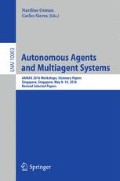Abstract
Urban growth has been widely studied and many models (in particular Cellular Automata and Agent-Based Models) have been developed. Most of these models rely on two representations of the geographic space: raster and vector. Both representations have their own strengths and drawbacks. The raster models are simpler to implement and require less data, which explains their success and why most of urban growth models are based on this representation. However, they are not adapted to microscopic dynamics such as, for example, the construction of buildings. To reach such goal, a vector-based representation of space is mandatory. However, very few vector models exist, and none of them is easily adaptable to different case studies. In this paper, we propose to use a simple raster model and to adapt it to a vector representation of the geographic space and processes allowing studying urban growth at fine scale. Both models have been validated by a case study concerning the city of Can Tho, Vietnam.
Access this chapter
Tax calculation will be finalised at checkout
Purchases are for personal use only
Notes
- 1.
We only use the urban-related entities from land use map in the following models.
References
GAMA website (2015). http://gama-platform.org
Acheampong, R.A., Silva, E.: Land use-transport interaction modeling: a review of the literature and future research directions. J. Transp. Land Use 8(3), 1–28 (2015)
Arsanjani, J.J., Helbich, M., de Noronha Vaz, E.: Spatiotemporal simulation ofurban growth patterns using agent-based modeling: the case of Tehran. Cities 32, 33–42 (2013)
Axelrod, R.M.: The Complexity of Cooperation: Agent-Based Models of Competition and Collaboration. Princeton University Press, Princeton (1997)
Banos, A., Sanders, L.: Modéliser et simuler les systèmes spatiaux en géographie. Modéliser et Simuler-Epistémologies et Pratiques des Modèles et des Simulations, Ebook des éditions Matériologiques, vol. 1, pp. 833–863 (2013)
Batty, M., Xie, Y., Sun, Z.: Modeling urban dynamics through GIS-based cellular automata. Comput. Environ. Urban Syst. 23(3), 205–233 (1999)
Benenson, I.: Multi-agent simulations of residential dynamics in the city. Comput. Environ. Urban Syst. 22(1), 25–42 (1998)
Boffet, A., Coquerel, C.: Urban classification for generalisation orchestration. In: 19th International Symposium of Photogrammetry and Remote Sensing (ISPRS 2000), Amsterdam, pp. 16–23, July 2000
Caruso, G., Vuidel, G., Cavailhès, J., Frankhauser, P., Peeters, D., Thomas, I.: Morphological similarities between DBM and a microeconomic model of sprawl. J. Geogr. Syst. 13(1), 31–48 (2011)
Clarke, K., Hoppen, S., Gaydos, L.: A self-modifying cellular automaton model of historical. Environ. Plan. B 24, 247–261 (1997)
Crooks, A.T.: Constructing and implementing an agent-based model of residential segregation through vector GIS. Int. J. Geogr. Inf. Sci. 24(5), 661–675 (2010)
Edmonds, B., Moss, S.: From KISS to KIDS – an ‘anti-simplistic’ modelling approach. In: Davidsson, P., Logan, B., Takadama, K. (eds.) MABS 2004. LNCS (LNAI), vol. 3415, pp. 130–144. Springer, Heidelberg (2005). doi:10.1007/978-3-540-32243-6_11
Grabisch, M., Labreuche, C.: A decade of application of the Choquet and Sugeno integrals in multi-criteria decision aid. Ann. Oper. Res. 175(1), 247–286 (2010)
Grignard, A., Taillandier, P., Gaudou, B., Vo, D.A., Huynh, N.Q., Drogoul, A.: GAMA 1.6: advancing the art of complex agent-based modeling and simulation. In: Boella, G., Elkind, E., Savarimuthu, B.T.R., Dignum, F., Purvis, M.K. (eds.) PRIMA 2013. LNCS (LNAI), vol. 8291, pp. 117–131. Springer, Heidelberg (2013). doi:10.1007/978-3-642-44927-7_9
Haken, H., Portugali, J.: The face of the city is its information. J. Environ. Psychol. 23(4), 385–408 (2003)
Hillier, B., Leaman, A., Stansall, P., Bedford, M.: Space syntax. Environ. Plan. B Plan. Des. 3(2), 147–185 (1976)
Liu, Y., Feng, Y.: A logistic based cellular automata model for continuous urban growth simulation: a case study of the Gold Coast City, Australia. In: Heppenstall, A.J., Crooks, A.T., See, L.M., Batty, M. (eds.) Agent-Based Models of Geographical Systems, pp. 643–662. Springer, The Netherlands (2012)
Louf, R., Barthelemy, M.: Modeling the polycentric transition of cities. Phys. Rev. Lett. 111(19), 198702 (2013)
Perret, J., Curie, F., Gaffuri, J., Ruas, A.: A Multi-agent system for the simulation of urban dynamics. In: 10th European Conference on Complex Systems (ECCS 2010), Lisbon (2010)
Raimbault, J., Banos, A., Doursat, R.: A hybrid network/grid model of urban morphogenesis and optimization. In: Aziz-Alaoui, M.A., Bertelle, C., Liu, X.Z., Olivier, D. (eds.) Proceedings of the 4th International Conference on Complex Systems and Applications (ICCSA 2014), pp. 51–60, June 2014
Torrens, P.M.: Simulating sprawl. Ann. Assoc. Am. Geogr. 96(2), 248–275 (2006)
van Vliet, J., Hagen-Zanker, A., Hurkens, J., van Delden, H.: A fuzzy set approach to assess the predictive accuracy of land use simulations. Ecol. Model. 261, 32–42 (2013)
Waddell, P.: Urbansim: modeling urban development for land use, transportation, and environmental planning. J. Am. Plan. Assoc. 68(3), 297–314 (2002)
Wegener, M.: Overview of land-use transport models. In: Handbook of Transport Geography and Spatial Systems, vol. 5, pp. 127–146. Pergamon/Elsevier Science, Kidlington (2004)
White, R.: Modeling multi-scale processes in a cellular automata framework. In: Portugali, J. (ed.) Complex Artificial Environments, pp. 165–177. Springer, Heidelberg (2006)
White, R., Engelen, G.: Cellular automata and fractal urban form: a cellular modelling approach to the evolution of urban land-use patterns. Environ. Plan. A 25(8), 1175–1199 (1993)
Acknowledgements
This work was part of and supported by the Tam Dao Summer School in Social Sciences (JTD) – http://www.tamdaoconf.com/.
Author information
Authors and Affiliations
Corresponding author
Editor information
Editors and Affiliations
Rights and permissions
Copyright information
© 2016 Springer International Publishing AG
About this paper
Cite this paper
Taillandier, P., Banos, A., Drogoul, A., Gaudou, B., Marilleau, N., Truong, Q.C. (2016). Simulating Urban Growth with Raster and Vector Models: A Case Study for the City of Can Tho, Vietnam. In: Osman, N., Sierra, C. (eds) Autonomous Agents and Multiagent Systems. AAMAS 2016. Lecture Notes in Computer Science(), vol 10003. Springer, Cham. https://doi.org/10.1007/978-3-319-46840-2_10
Download citation
DOI: https://doi.org/10.1007/978-3-319-46840-2_10
Published:
Publisher Name: Springer, Cham
Print ISBN: 978-3-319-46839-6
Online ISBN: 978-3-319-46840-2
eBook Packages: Computer ScienceComputer Science (R0)

